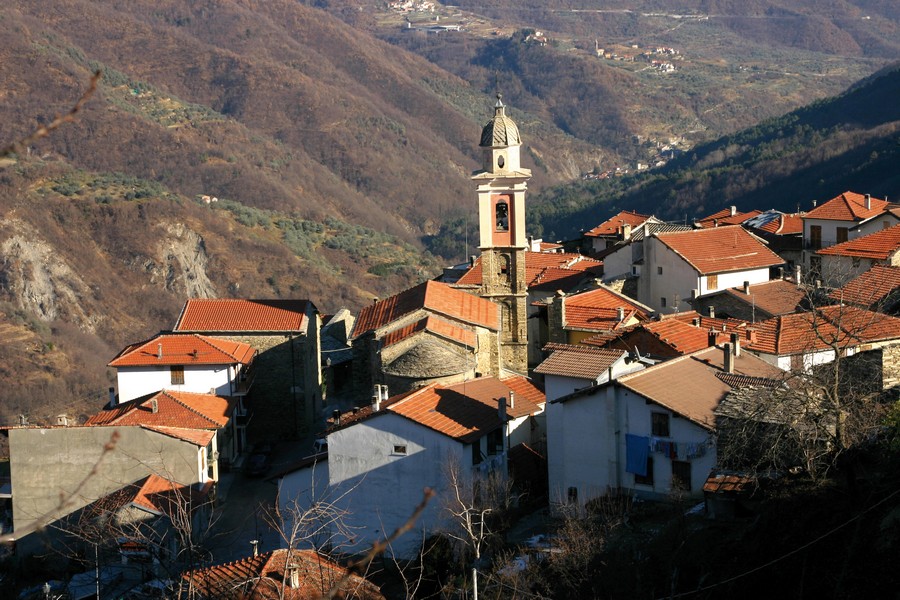Altitude: 721 m a.s.l.
Area: 10 sq km
Distance from Imperia: 31 km
Inhabitants: in 1881: 469 - in 2017: 118
Patron Saint Day: February 3rd - San Biagio
Information: Municipality phone 0183 328731
Montegrosso is a typical Ligurian mountain village with a sylvan-pastoral economy that has historically followed the fate of Pornassio.
The epithet "Pian Latte", which properly refers to the contiguous mountain pass from which the present town developed in ancient times (and is mentioned as Planum Lactis in medieval sources), constitutes a further and explicit reference to the widespread practice of breeding.
Visit of the town
After passing at the beginning of the village the chapel of Madonna delle Grazie on the right side of the road and the chapel of San Sebastiano on the opposite side, park in the open space on the left and walk to the parish church of San Biagio, of fourteenth-century origin but entirely rebuilt in Baroque times when the porch with seats was added to the front; on the opposite side of the road is the Baroque oratory of San Biagio of 1783, home of the homonymous confraternity.
Circumventing on the right the church, which preserves Baroque frescoes inside the apse, reach the side door protected by the little portico and enriched by a monolithic architrave of 1435 carved with an Agnus in the center, an angel with a scroll fluttering on one side and on the other side San Biagio with a book in his hand, a vase of flowers and a goat; a little further on rises the stone bell tower which preserves in the lower part the loophole that reveals its military use.
Going along the little road upstream of the apse you’ll find under the vault on the left an architrave of 1583 carved in a Trigram; from there return to the churchyard and then go up the porphyry stone steps that lead to Piazza Caduti, where a giant monolithic lintel carved with a Trigram in a radial pattern, a vase of stylized flowers and an Agnus is affixed in front of you.
Going up the central Via IV Novembre you’ll see in the widening on the right the public oven that cooked the bread of the whole village; to avoid uncontrolled promiscuity, however, several families had joined together with their own common oven, such as the one located under the archivolt on the left on Via Sant'Anna which branches off in front of the nearby fountain; other houses have their own private ovens in the kitchen.
The buildings, in the simple poor mountain architecture well evident around there and also along Via San Marco, end a little higher up with the bare chapel of San Bernardo flanked by the fountain that, together with the oven, exhausts the network of public services of this poor economy of survival.
Turning back, just before Piazza Caduti take the road on the right that shows -in the houses that stand on its sides- what it was, what it is, and unfortunately -with its ruins- also what could be of this town.
After leaving the built-up area in half an hour of well-kept path you can reach the chapel of San Lorenzo; one hundred meters after, "Prato delle Ciane" opens up among the chestnut trees, at the end of which the ruins of the gloomy walls of Cà Longa, the ancient penitentiary of the Republic of Genoa, survive along with the rustic “casoni” used now only occasionally during the chestnut harvest.
The path then continues on level ground in the grove, taking you in a fifteen minutes walk to the waterfalls of the Bastia torrent that falls over you forming a tiny pond; a half-hour walk further ahead is the "Bosco delle ciase", well known by those who go for mushrooms.
Returning back and picking up the car, you can get around the village and, leaving the Sant'Anna chapel on the left, continue taking the right at the junction towards "Case Fascei" where the mountain houses called "Tecci", modest constructions once inhabited by the shepherds, stand on the grassland at 1200 meters of altitude; several have already been transformed into cottages that, if on the one hand they horrify the purists, on the other they are auspicious for the future of the village.
Once back to the Provincial Road take the left to Mendatica.


